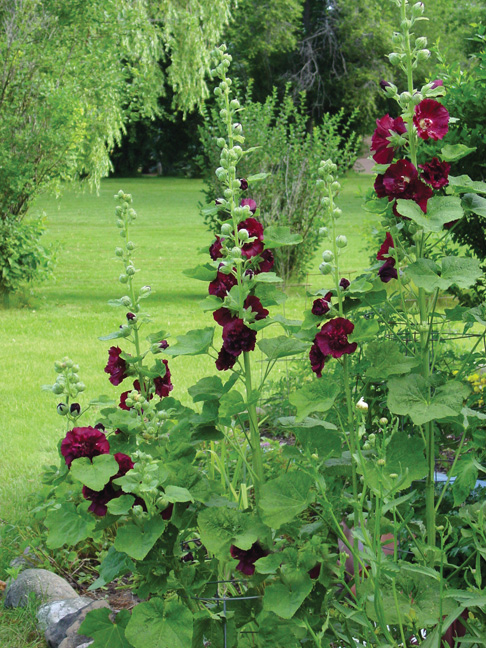I have always liked hollyhocks, but had not tried to grow them until recently. In visiting one of my sisters a few years ago, I noticed a hollyhock clump in her garden that was at least 7 feet tall with very dark maroon flowers (A. rosea ‘Nigra). I could just visualize those flowers in my garden and I knew exactly where I would plant them in our yard. Luckily sister was very generous in sharing seeds from her plant and I went home and immediately planted my hollyhocks.
Being familiar with hollyhocks plants, I knew that they liked a lot of sun and that once established, they were reasonably drought tolerant. Also, since they are biennial, I knew that it would be 2 years before my hollyhocks would bloom. I didn’t want a huge patch of hollyhocks, just a specimen clump that would make a colorful statement in the yard.
That first year my plants grew and looked very healthy and by the second year they started to bloom. I was excited to see that my hollyhocks looked as good in the garden as I had imagined. Since the mother plants generally die after producing seeds, I watched them bloom that summer and then cut down the flower stalks to keep them from setting seed. I hoped that would encourage them to become more of a perennial. That idea has worked for the last 4 years. Each year my hollyhocks grew tall and were covered with blooms.
However, this year, something was different. The flower clump only grew to be 2 feet tall and had very few flowers. I was not sure if my hollyhocks had gotten too old or if they are just tired and no longer interested in blooming. I thought I would try adding more compost next year, but just in case, I saved some seeds. One way or another, I am determined to keep hollyhocks as part of my flower garden.
The only pest for this plant is a disease called Hollyhock Rust, (the real name is Puccinia malvacearum) and it can disfigure the leaves under severe infestations making them look scabby and ugly. It shows up as reddish raised bumps on the leaves and if you grow hollyhocks, eventually you are going to have rust. It is very widespread and even overwinters in cold climates by infecting the plant crowns. Lime sulfur spray is recommended to reduce the spread of this disease.
While there is no cure for hollyhock rust and all hollyhocks can get it, rust usually only kills plants that are under stress so a little care goes a long way. During the growing season adding bit of compost around the plant and watering when things get really dry helps. Then in fall, pulling out the old hollyhock stalks, removing plant crowns and cleaning up any litter reduces the chance of hollyhock rust overwintering. It sounds a bit tedious, but I think those beautiful tall spikes of color are well worth the effort!





I MUST have some of those hollyhocks next year!!!